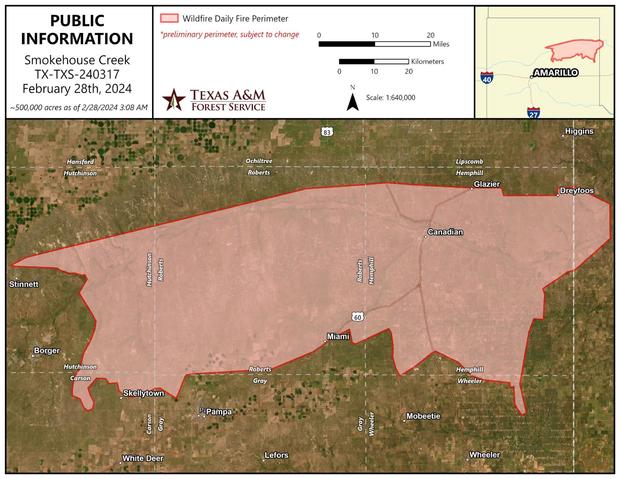Smokehouse Creek Fire in Texas explodes to become second-largest wildfire in U.S. history after burning 1.1 million acres
In the Texas Panhandle, lampposts are now melted, power line posts are split in half and homes and properties have been reduced to charred remains. The Smokehouse Creek Fire that broke out on Monday has since extended to nearly 1.1 million acres, firefighters said Thursday, quickly becoming the "largest and most destructive" in state history.
As of Thursday night, the fire located in Hutchinson County was about 1.075 million acres and remained just 3% contained, according to the Texas A&M Forest Service.
"This is now both the largest and most destructive fire in Texas history," the West Odessa Volunteer Fire Department wrote on Facebook. "It is also the second largest wildfire in U.S. history."
The nearby 687 Reamer Fire that started in the same county has now "burned into this fire," the Forest Service said.
At least two people have died in the Smokehouse Creek Fire. One person died in Hutchinson County, a county official told CBS Texas on Wednesday night. The victim's grandson confirmed the death to CBS News, identifying the victim as 83-year-old Joyce Blankenship.
On Thursday, Texas Highway Patrol confirmed that a female driver traveling down a road in Hemphill County suffered burns after exiting her truck. She was discovered by a passerby and rushed by ambulance to an Oklahoma hospital, where she died, highway patrol said. Her name was not immediately released.
In some areas, Texas first responders contended with snow and frigid conditions Thursday. Firefighters from across the state have responded to provide assistance.
President Biden, who was visiting the southern Texas border Thursday, told reporters that he has directed his team to do "everything possible to help protect the people in the communities threatened by these fires."
Mr. Biden said that 500 federal personnel had already been deployed to the Panhandle, with more on the way.
Some residents were returning to their communities to find what was left of their homes and lives.
"Where the fire was, I figured I was alright," said Jerry Harrah of Fritch, which is located in the center of the Texas Panhandle. "Until I turned around, and it was right across the street from me. And I got burned trying to get out of there."
Tyler McCain's family got out just hours before their Fritch home burned to the ground. They lost just about everything.
The family is now staying at a home offered to them by a stranger on Facebook.
"We're in that Airbnb until Monday," McCain said. "After that, we've got to figure out what we're doing, day by day."
On Wednesday, the Forest Service increased the state's wildland fire preparedness level to a 3 out of 5, meaning that "wildfire activity is impacting several regions of the state as the result of drought, dry vegetation or frequent fire weather events."
There are at least five active wildfires throughout the state, with the Smokehouse Creek Fire being the largest by far. The second-largest active wildfire as of Thursday is the Windy Deuce Fire in Moore County, which has grown to an estimated 142,000 acres and is 55% contained, according to the Forest Service.
Other active wildfires include the Grape Vine Creek Fire in Gray County and the Magenta Fire in Oldham County.
The Smokehouse Creek Fire had reached historic levels after just a few days. Previously, the biggest fire to ever ignite in Texas had been 2006's East Amarillo Complex fire, which grew to more than 907,000 acres.
The fire also destroyed most of the historic $180 million Turkey Track Ranch, which was home to "one of the largest and bloodiest battles of the Great Plains" near the end of the Civil War, and the site of the Red River War that started in 1874. The property, one of the oldest ranches in the state that covers roughly 80,000 acres, has seen an estimated 80% of its pastures, plains and creek bottom burned in the fire, CBS affiliate KHOU-TV reports.
"The loss of livestock, crops and wildlife, as well as ranch fencing and other infrastructure throughout our property as well as other ranches and homes across the region is, we believe, unparalleled in our history," the owners said in a statement. "...We are all completely devastated and personally heartbroken by the magnitude of this horrific event."
The Forest Service said the Smokehouse Creek Fire is part of a multi-day wildfire outbreak across Texas and Oklahoma.
The fires temporarily shut down Pantex, the main facility that puts together the country's nuclear arsenal, but the facility, located about 30 miles east of the Panhandle city of Amarillo, is back to "normal day shift operations." No damage or issues were reported.
Wildfires as a whole are anticipated to only worsen as the world continues to burn fossil fuels that release planet-warming greenhouse gases. Last year, scientists at Climate Central released a report finding that wildfire seasons in the U.S. are "lengthening and intensifying, particularly in the West."
Texas Gov. Greg Abbott issued a disaster declaration for 60 Texas counties on Tuesday to secure resources to help fight the massive blazes. High temperatures and dry and windy conditions — all of which are expected to become a more frequent and intense problem as global temperatures rise — contributed to the spread of the flames, Abbott said, with those conditions expected to remain for at least a few days.
"These conditions could increase the potential for these wildfires to grow larger and more dangerous," the governor said. "Texans are urged to limit activities that could create sparks and take precautions to keep their loved ones safe."
Before Tresea Rancin escaped the Smokehouse Creek Fire, she watched as her home of 38 years in the town of Canadian went up in flames.
"I was Facetiming with my son, who is in the service, and he said 'Mom leave,'" Rancin told CBS News.
Rankin says she will rebuild.
"You got a choice, you can either get bitter or get better, and I'm getting better," she said.
As fast-moving flames quickly spread over the dried grassland, cattle ranchers near the town of Sinton released livestock to escape the flames.
Several school districts in the Texas Panhandle were closed Wednesday, and residents who didn't get out in time were being told to shelter in place.
"We asked them to leave because it's a very dangerous situation," Ellis County Sheriff Shane Booth said.
The Smokehouse Creek Fire has burned more than 31,000 acres in Oklahoma as of Thursday, according to Oklahoma Forestry Services. At least 13 homes in Oklahoma have also been destroyed, according to the Oklahoma Department of Emergency Management.
Today, several states, including Texas, have two additional months of fire weather compared to what was experienced in 1973, the group found. A combination of low humidity, hot temperatures and wind promotes the spread of wildfires.
"Human-caused climate change accounts for at least two-thirds of the rapid increase in fire weather in the western U.S. in recent decades," Climate Central says.
While temperatures are expected to be cooler in north Texas in the middle of this week, the National Weather Service says that warmer conditions will return by Friday, with temperatures 10 to 20 degrees above normal. However, some additional moisture is also expected and the service says that there could be some rain as early as Sunday.
— Dave Malkoff contributed to this report.
for more features.








